5 AI Tools for Energy-Efficient Garden Design
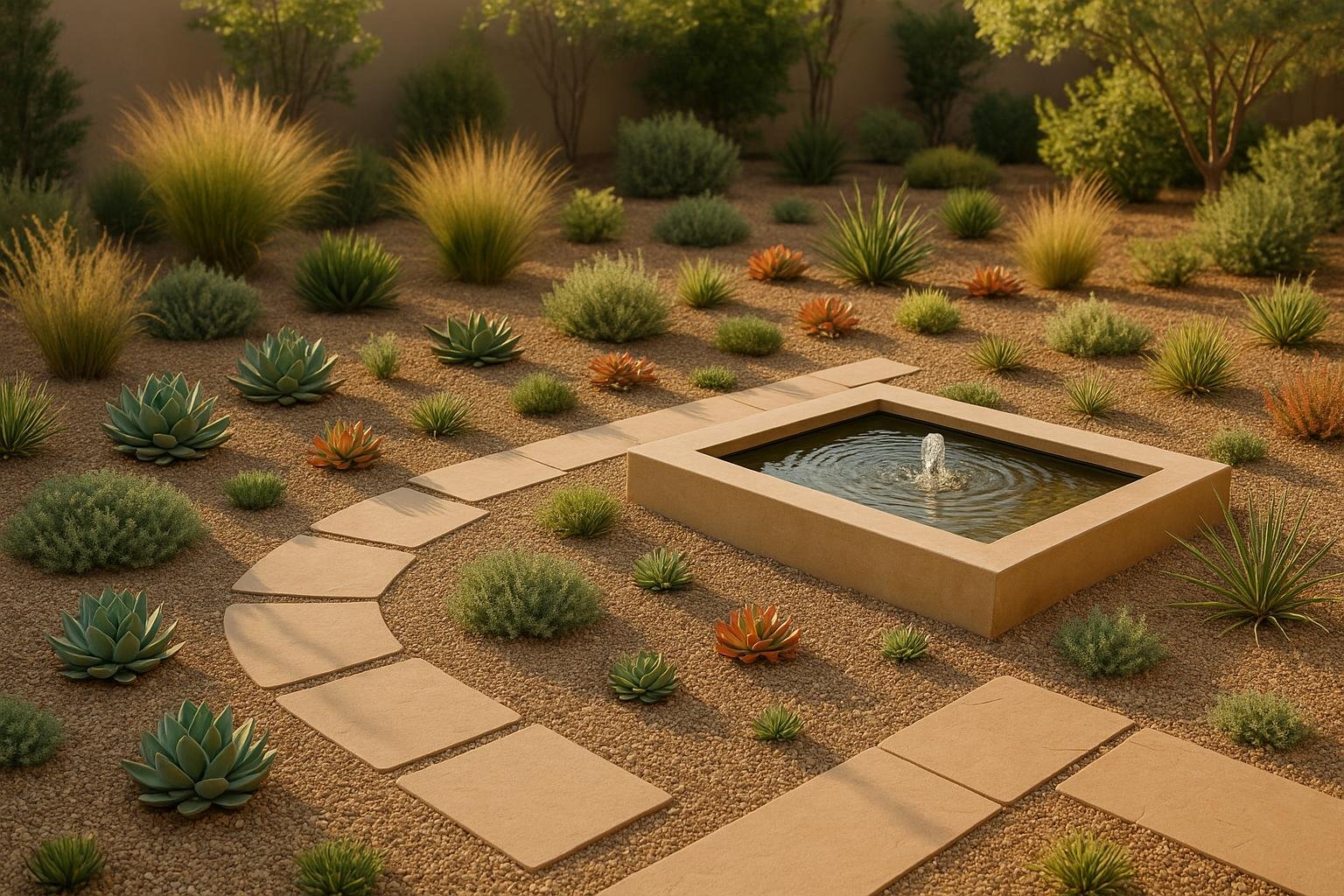
AI tools are revolutionizing garden design, making it easier to create water-efficient, low-maintenance, and climate-friendly outdoor spaces. Whether you're battling high energy costs, water restrictions, or extreme weather, these tools simplify the process while saving time and resources. Here's a quick look at what they offer:
- AIGardenPlanner: Creates custom garden layouts based on local climate, soil, and plant compatibility. Offers over 50 design styles and smart water management tools. Pricing starts at $15.
- AITWO: Focuses on water-efficient landscaping and microclimate analysis. Suggests drought-resistant plants and precise irrigation schedules.
- HomeDesignsAI: Provides 3D visualizations and suggests water-smart landscaping, energy-efficient lighting, and weather-resistant materials.
- AI-Powered Smart Irrigation Systems: Uses real-time data to optimize watering schedules, cutting water use by up to 70%.
- AI Plant Advisor and Species Selector: Recommends plants tailored to your local conditions, with a 98% accuracy rate in plant identification and disease diagnosis.
Quick Comparison Table
| Tool | Water Conservation | Climate Adaptation | Plant Selection | Customization Options |
|---|---|---|---|---|
| AIGardenPlanner | Efficient watering schedules | Climate-specific designs | Tailored plant recommendations | 50+ design styles, photo uploads |
| AITWO | Drought-resistant plants | Microclimate analysis | Native species database | Themed garden options |
| HomeDesignsAI | Water-smart landscaping | Weather-resistant materials | Optimized plant database | 3D visualization, layout tools |
| AI-Powered Smart Irrigation | Real-time water monitoring | Predictive weather analytics | Zone-specific irrigation | Mobile app for full control |
| AI Plant Advisor | Drought-tolerant plants | Hardiness zone matching | Companion planting recommendations | Plant simulations, maintenance tips |
These tools make energy-efficient gardening accessible for everyone, from homeowners to professional landscapers. Start saving water, cutting energy costs, and designing gardens that thrive in your climate - all with the help of AI.
How to use AI to Make Garden Planning More Efficient (8 Prompts You Can Use Today)

1. AIGardenPlanner
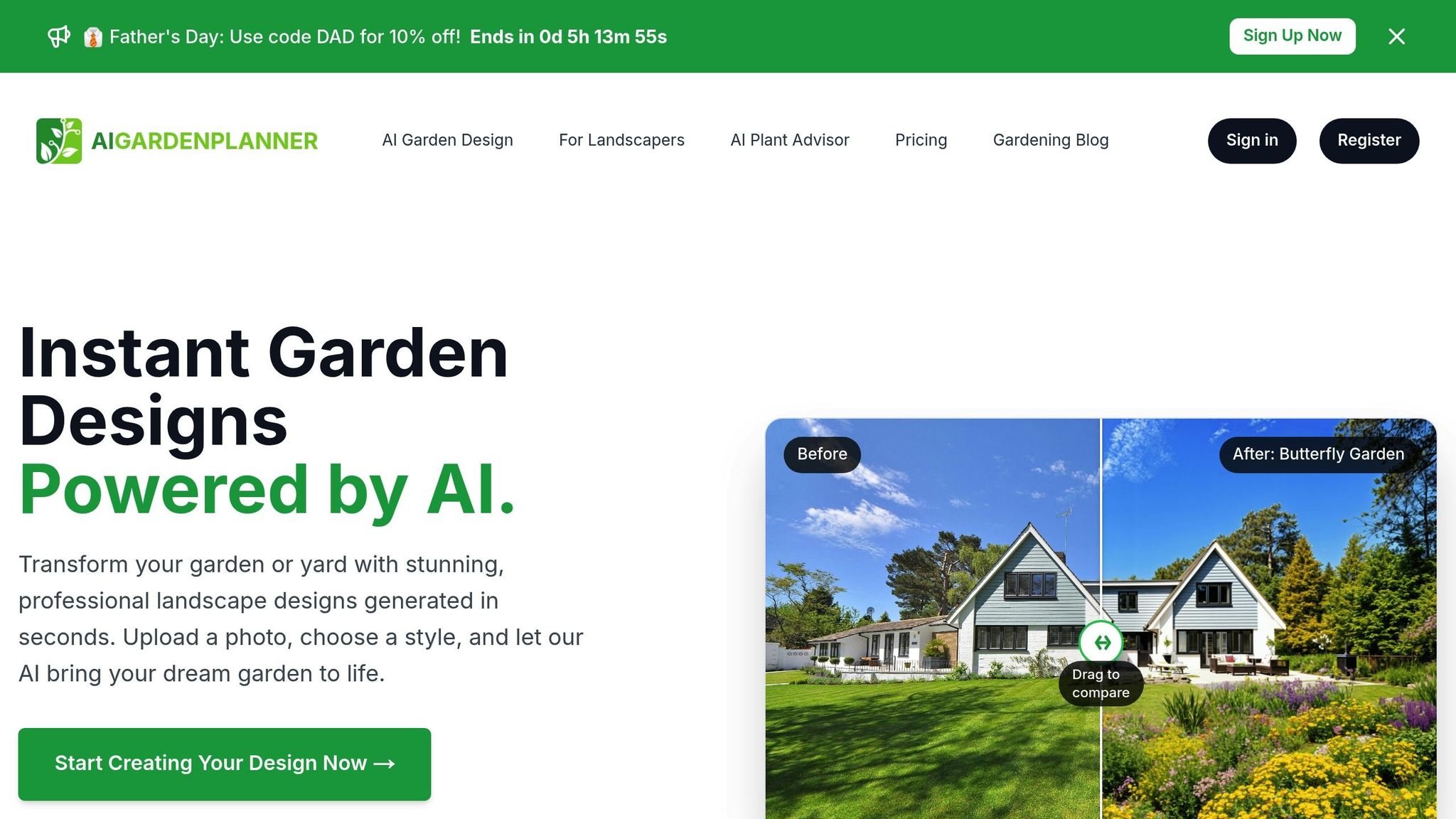
AIGardenPlanner is a smart garden design tool that transforms photos of your outdoor space into energy-conscious, professional layouts. Using advanced algorithms, it evaluates your garden's specific conditions to create designs tailored to your local environment and climate.
Climate-Specific Features
The tool takes into account factors like your region's climate, hardiness zone, soil quality, and plant compatibility. This ensures that the plant recommendations it provides align with your garden's unique needs.
Tailored Plant Suggestions
AIGardenPlanner delivers personalized plant recommendations based on your location, gardening experience, and goals. It factors in sunlight exposure, water requirements, and the mature size of plants to ensure the best fit for your space. Whether you're uploading a garden photo or sketching dimensions directly in the app, the tool adjusts its suggestions to suit your specific setup.
Smart Water Management
To help conserve water, AIGardenPlanner calculates efficient watering schedules by analyzing local weather patterns and soil conditions. It prioritizes plants that naturally thrive with less water, promoting sustainable irrigation practices. This approach not only saves water but also integrates seamlessly with the tool's broad customization options.
Design and Customization
AIGardenPlanner goes beyond functionality by offering a wide range of design styles - over 50 options, including Japanese Zen, Mediterranean, Modern Minimalist, and Tropical Paradise themes. You can tailor your garden's look to reflect your personal style, and each plan is accompanied by detailed guides to help you maintain an energy-efficient garden throughout the year.
With professional-level design tools at a fraction of the cost, AIGardenPlanner is an affordable option for homeowners. Pricing starts at $15 for occasional users, with monthly plans beginning at $19, making it accessible for a variety of budgets.
2. AITWO

AITWO is an AI-powered platform designed to transform backyards into water-efficient, eco-conscious spaces. By analyzing environmental data, it helps reduce unnecessary resource use and implements smart water-saving strategies.
Water Conservation Capabilities
AITWO specializes in creating water-efficient landscapes by incorporating drought-resistant plants and xeriscaping techniques. It evaluates local water restrictions and climate patterns to suggest plants that thrive with minimal irrigation.
The platform also calculates precise watering schedules based on factors like soil moisture, weather forecasts, and plant requirements. Irrigation systems are activated only when truly necessary.
"We waste too much water, and many urban areas face severe shortages. Imagine the savings in large developments when irrigation runs only on demand."
Climate Adaptation Features
AITWO tailors its designs to fit your garden's unique microclimate. By analyzing data on temperature changes, humidity, and sunlight exposure, it recommends plants and protective measures that enhance survival and growth. The platform also adjusts design elements to address challenges like extreme heat, frost, or excess moisture. Real-time updates ensure that your garden stays healthy and vibrant, no matter the season.
Personalized Plant Recommendations
AITWO provides plant suggestions specifically suited to your yard's conditions. It considers factors like hardiness zones, soil type, and local climate to ensure the selected plants align with both your aesthetic preferences and environmental needs.
🚀 Ready to Reinvent Your Garden?
Join thousands of homeowners who have transformed their gardens using our AI design tool. Upload one photo to explore endless possibilities.
Get your AI garden designs →3. HomeDesignsAI
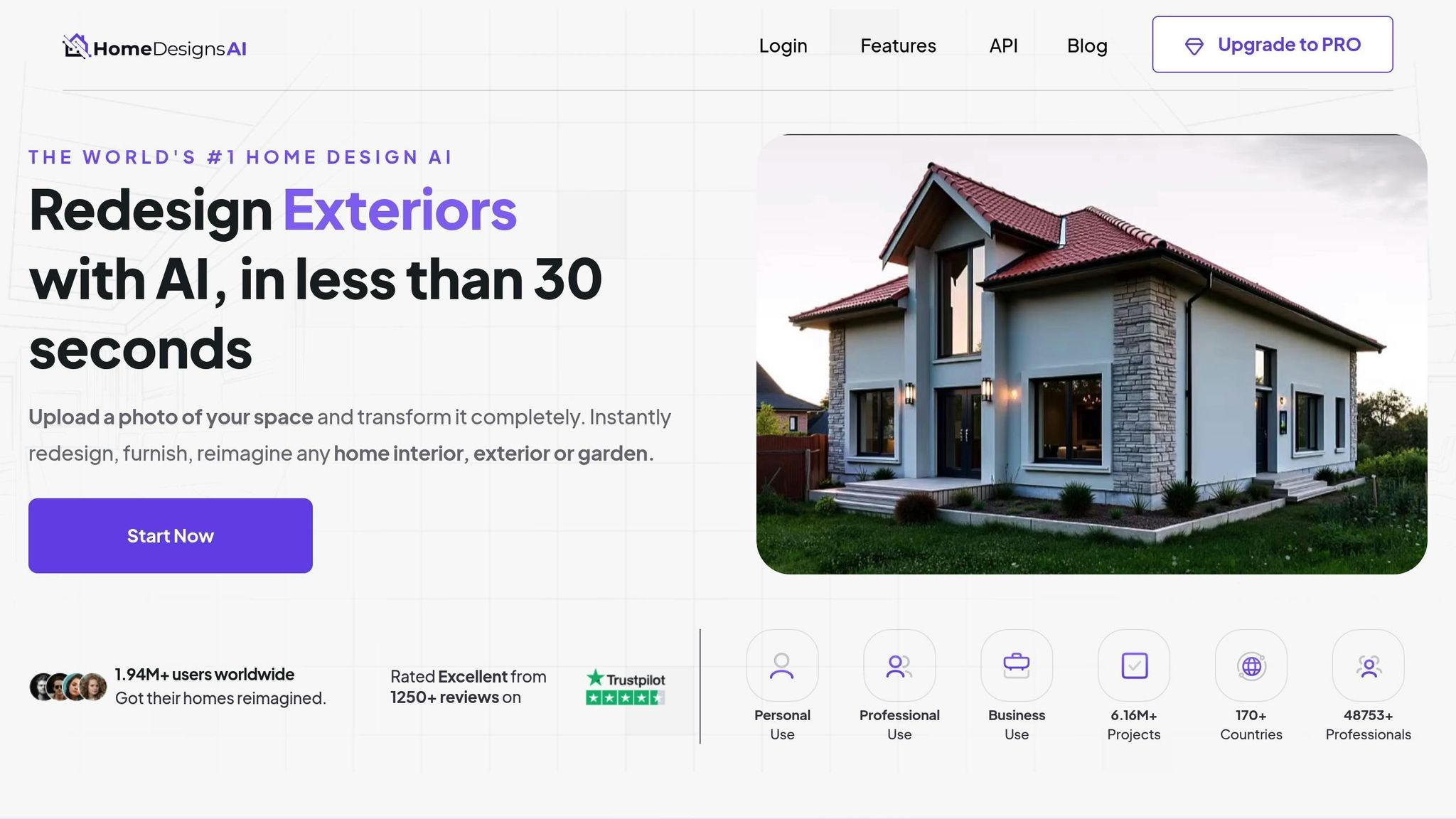
HomeDesignsAI is changing the way outdoor spaces are designed by using AI to create energy-efficient and environmentally friendly designs. With over 1.9 million users across 170+ countries, this platform has become a go-to choice for people seeking practical and sustainable outdoor solutions. Let’s take a closer look at how it helps with water conservation and climate adaptation while offering impressive customization options.
Water Conservation Capabilities
HomeDesignsAI focuses on helping homeowners conserve water, a critical need in drought-prone areas of the U.S.. The platform suggests plant combinations that thrive on minimal water, allowing users to preview how these designs will perform before making any commitments. This feature not only reduces the risk of costly errors but also supports long-term water-saving goals.
Climate Adaptation Features
When it comes to adapting outdoor spaces for varying climates, HomeDesignsAI stands out. It goes beyond just plant recommendations by suggesting weather-resistant materials for outdoor structures. The platform also integrates energy-efficient lighting solutions, such as solar-powered systems or low-energy LED options, helping to reduce energy use and carbon emissions. These tools make it easier to create outdoor spaces that are both resilient and sustainable.
Visualization and Customization Options
With HomeDesignsAI, turning your vision into reality is simple. Upload a photo of your space, and the platform can transform it using more than 80 design styles. You can customize colors, textures, and even simulate different weather conditions to ensure the design fits your preferences. The platform also allows users to experiment with plant selections, furniture arrangements, and lighting setups. Its Fill Spaces tool automatically generates optimal furniture layouts, making it easy to compare different options quickly. Plus, you can adjust how much input the AI has, tailoring the design to your personal style and maintenance preferences.
sbb-itb-4d6a8dd
4. AI-Powered Smart Irrigation Systems
AI-powered smart irrigation systems take the guesswork out of watering by using real-time data from soil sensors, weather forecasts, and plant information to create precise schedules. These systems not only save water but also adjust effortlessly to changing weather conditions, making them a game-changer for efficient water use.
Water Conservation Capabilities
These systems can cut water usage by anywhere from 40% to over 70%, depending on the setup and environmental factors. By constantly monitoring soil moisture and analyzing weather patterns, they automatically adjust watering schedules to avoid overwatering or underwatering.
A great example of their impact is Frosty Vineyards in Napa Valley, California. By implementing an AI irrigation system that tracks temperature and humidity, they managed to reduce water use by 30% while boosting grape yields.
Climate Adaptation Features
AI-powered irrigation systems shine in their ability to respond to extreme weather. They use predictive analytics to adjust watering schedules during rain, storms, or heat waves, ensuring soil moisture stays at optimal levels. For instance, if a storm is on the horizon, the system can delay watering, while during a heat wave, it can tweak schedules to reduce evaporation.
"Smart irrigation systems are emerging as a vital tool to enhance water conservation, resource efficiency and crop resilience." - United Nations University
By analyzing historical data, these systems improve their accuracy over time, allowing for better predictions of irrigation needs. This can lead to up to a 25% reduction in water use while increasing crop yields by 20–30%.
Visualization and Customization Options
These systems don't just save water - they also give users full control over how and when their plants are watered. Many modern systems come with mobile apps that let you customize irrigation zones based on plant types and soil conditions. For instance, you can ensure that water-intensive vegetables get the care they need while drought-tolerant plants receive minimal watering - all handled automatically.
When choosing a smart irrigation system, think about your landscape's size, the types of plants you have, and your budget. Look for systems with sensors that measure soil moisture, temperature, light, and humidity to get a complete picture of your garden's needs. With remote monitoring, you can reduce manual labor and gain valuable insights into water usage and plant health trends.
5. AI Plant Advisor and Species Selector
AI plant advisors and species selectors are transforming how we approach energy-efficient gardening. By analyzing your site’s unique conditions, these tools recommend plants that thrive with minimal resources. They go beyond basic plant lists, taking into account factors like local climate, hardiness zones, soil type, and sunlight availability to create tailored planting plans.
Personalized Plant Recommendations
These tools evaluate your specific gardening environment - climate, soil, sunlight, and more - to suggest plants that align with your goals and experience level. As AIGardenPlanner puts it:
"Our AI analyzes your unique conditions to suggest the perfect plants for your space." – AIGardenPlanner
They also provide growing guides, maintenance schedules, and seasonal planning tips based on your region’s growing cycles. This reduces the trial-and-error process, helping you avoid plant failures and wasted resources. Additionally, they fine-tune plant selections to address local climatic challenges, ensuring your garden thrives.
Climate Adaptation Features
AI species selectors are particularly skilled at recommending plants suited to your environment. For example, they suggest drought-tolerant varieties for arid regions and frost-resistant species for colder climates. These tools even consider microclimatic factors, such as shaded or windy areas, to refine their recommendations. By aligning plant choices with the local environment, these tools help create gardens that conserve resources naturally.
Water Conservation Capabilities
Water-efficient gardening is another major focus. AI advisors often recommend native or drought-tolerant plants that require little to no supplemental irrigation once established. A community garden project illustrated how AI-driven plant selection, combined with rainwater harvesting and greywater recycling, significantly reduced reliance on municipal water sources. These tools can also suggest companion planting strategies to improve overall garden health and minimize maintenance needs.
Visualization and Customization Options
By inputting details like topography, existing vegetation, and aesthetic preferences, users can receive highly specific plant recommendations. Many tools also offer visual simulations to help with long-term planning. For instance, they can identify the best spots for trees and shrubs to provide natural shade, potentially lowering your home’s cooling costs during summer.
"AI is enabling sustainable gardening, offering tools that optimize resources and promote harmony with nature." – Dr. Alexander Tabibi, Entrepreneur, Investor, and Advocate for Sustainable Innovation
These AI-driven tools are redefining garden planning, making it easier than ever to create resource-efficient, sustainable landscapes for gardeners of all skill levels.
Tool Comparison Table
This table provides a quick overview of AI tools focused on water conservation, climate adaptation, plant selection, and customization. It highlights the core strengths of each tool and their specialized features, complementing the detailed descriptions provided earlier.
| Tool | Water Conservation | Climate Adaptation | Plant Selection | Customization Options | Key Strengths |
|---|---|---|---|---|---|
| AIGardenPlanner | Recommends drought-tolerant plants | Analyzes U.S. hardiness zones with seasonal planning | Offers 50+ garden styles and location-based suggestions | Allows photo uploads, custom style creation, and 15–500 designs/month (plan-dependent) | Detailed climate analysis and an extensive style library* |
| AITWO | Optimizes irrigation with native plants | Provides microclimate analysis and bloom scheduling | Features a database of native, pollinator-friendly species | Includes themed garden options like Japanese or kid-friendly designs | Advanced microclimate analysis and seasonal bloom planning |
| HomeDesignsAI | Suggests water-smart landscaping and rain garden plans | Considers regional climate and temperature-specific needs | Offers a plant database optimized for climate | Provides 3D visualization, material selection, and layout customization | Excels in 3D visualization for garden layouts |
| AI-Powered Smart Irrigation Systems | Monitors soil moisture in real-time and schedules watering based on weather | Sends alerts for evapotranspiration and frost conditions | Focuses on precise irrigation | Supports programmable, zone-specific schedules | Highly accurate irrigation scheduling |
| AI Plant Advisor and Species Selector | Identifies drought-resistant species and estimates water usage | Matches plants to hardiness zones and seasonal growth patterns | Achieves 98% accuracy in plant identification and disease diagnosis | Offers companion planting ideas and maintenance schedules | Industry-leading plant identification accuracy |
*Pricing ranges from $15 for occasional users to $42 per month for advanced business solutions.
Each tool brings a unique advantage depending on gardening priorities. AIGardenPlanner shines with its design flexibility, offering tailored styles and precise climate analysis, making it a go-to choice for gardeners balancing aesthetics with environmental considerations. Its ability to analyze local weather, soil types, and hardiness zones ensures optimal plant selection.
For water conservation, AI-Powered Smart Irrigation Systems lead the way. These systems use AI to calculate watering schedules based on real-time weather data, soil moisture, and evapotranspiration rates. This makes them especially valuable in areas with water restrictions or high utility costs.
AITWO stands out for climate adaptation, using microclimate analysis to address factors like wind exposure and shade patterns. Its seasonal garden planning tools are particularly helpful for navigating challenging growing conditions across diverse U.S. regions.
When it comes to plant selection, AI Plant Advisor and Species Selector takes the lead with a 98% accuracy rate in identifying plants and diagnosing diseases. This precision is vital for choosing native species that naturally require less water and support sustainable gardening practices.
Most tools offer better pricing with annual subscriptions, making them accessible to both homeowners and professional landscapers. These AI-driven solutions are paving the way for creating sustainable, resource-efficient outdoor spaces.
🎨 Visualize Your Dream Garden Today!
Transform any outdoor space into a professional landscape design in minutes. Just upload a photo, choose your style, and let our AI do the rest.
Start your garden transformation now →Conclusion
AI tools are transforming garden design across the U.S., offering tailored solutions for different climates. From the dry landscapes of the Southwest to the lush, humid environments of the Southeast, these technologies tackle pressing issues like water conservation and adapting to changing climate conditions.
One standout achievement is their impact on water usage. For instance, some systems have cut water consumption by as much as 50% by fine-tuning irrigation schedules and promoting the use of drought-tolerant plants.
Beyond conserving water, these tools excel in helping gardens adapt to local climates. By analyzing factors like sunlight, soil quality, hardiness zones, and even microclimates, AI can recommend plants that are naturally suited to specific areas. This approach not only improves plant health but also enhances overall garden efficiency.
Additionally, AI-IoT systems bring real-time monitoring into the mix. With mobile apps, gardeners can now track soil conditions and adjust irrigation on the fly, making sustainable gardening more accessible than ever. These data-driven tools prove that eco-friendly garden design isn’t just possible - it’s practical.
For gardeners across the country, these innovations offer smart solutions to challenges like water shortages, unpredictable weather, and rising energy costs. Whether you’re creating a drought-tolerant yard in California or planning seasonal crops in the Midwest, AI provides the insights needed to make choices that benefit both your garden and the planet.
The future of gardening in America is rooted in AI-powered, environmentally conscious design.
FAQs
How can AI tools help make garden designs more water-efficient and energy-saving?
AI tools for garden design are transforming how we approach water and energy conservation. By evaluating details like weather patterns, soil moisture, and the specific needs of your plants, these tools can create tailored watering schedules. The result? Less waste and up to a 30% reduction in water use.
But that’s not all. These systems also help you choose and position plants suited to your local climate, ensuring they flourish with minimal effort. This means less energy spent on watering, heating, or cooling outdoor areas, making your garden not only environmentally friendly but also easier on your wallet.
What do AI tools consider when suggesting plants for your garden?
AI tools evaluate a variety of factors to suggest plants that will flourish in your garden. They consider soil type, climate, sunlight exposure, and local conditions. On top of that, they factor in your personal preferences, whether it's specific plant aesthetics or how much upkeep you're willing to manage.
By merging this information, these tools offer customized recommendations that match your garden's unique needs, helping you create a thriving and low-maintenance outdoor space.
How do AI-powered irrigation systems optimize watering schedules using real-time data?
AI-driven irrigation systems rely on real-time data from tools like soil moisture sensors, weather forecasts, and plant health monitors to fine-tune watering schedules. By processing this information, they calculate the best timing and precise amount of water plants need, promoting healthy growth while reducing water waste.
These systems shine when it comes to adjusting to shifting weather patterns. They can prevent overwatering during rainy spells and respond effectively to drought conditions. The result? Water conservation paired with efficient garden care that’s easier on resources.
Related posts
Related Articles

AI-Driven Garden Furniture Placement: How It Works
Transform your garden with AI-driven furniture placement that optimizes style, comfort, and functionality based on your space and preferences.

15 Low-Maintenance Plants for Busy Homeowners
Explore 15 low-maintenance plants perfect for busy homeowners seeking greenery without the hassle of intensive care.
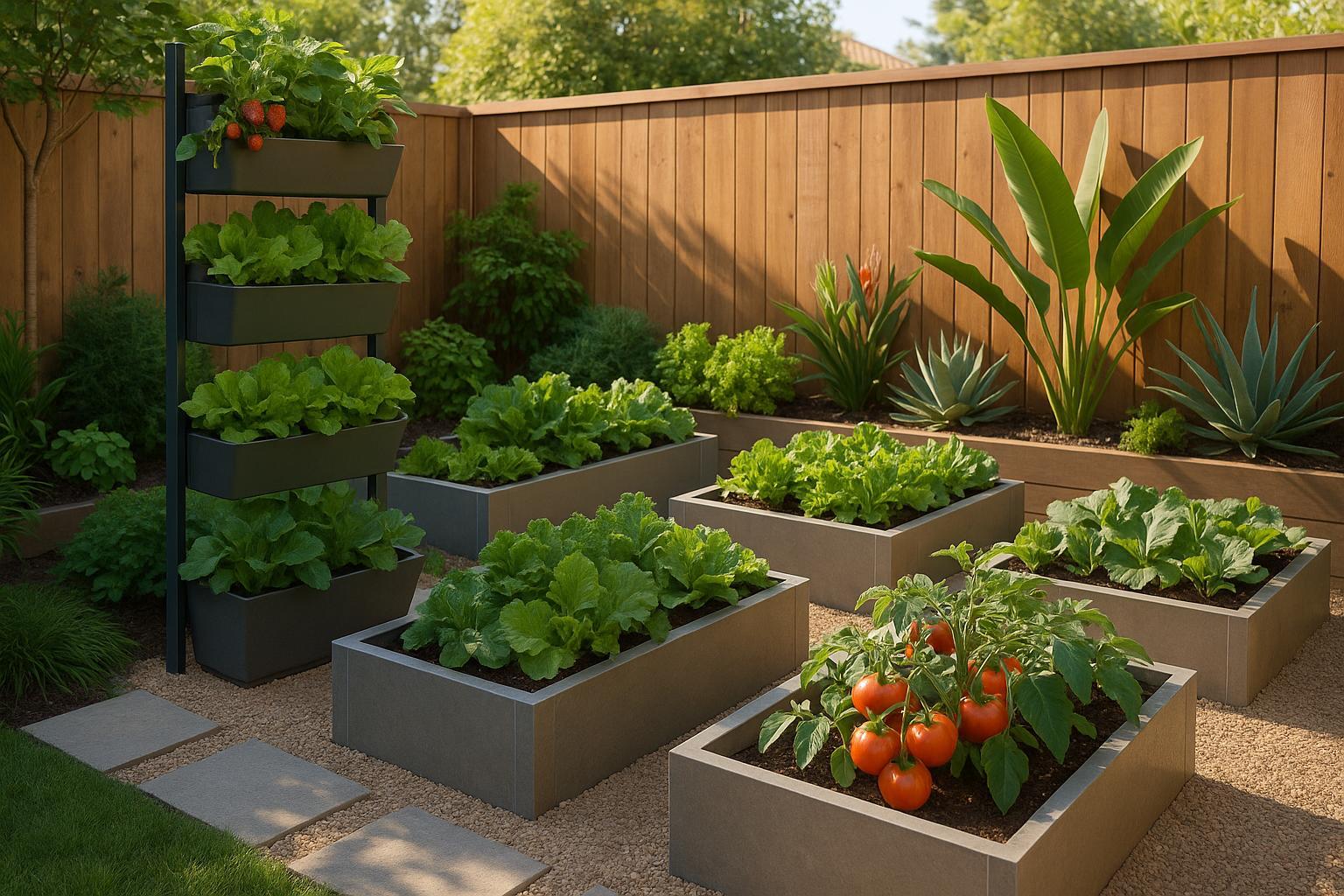
How AI Helps Maximize Space in Any Climate
Explore how AI revolutionizes garden design, optimizing space and sustainability tailored to your climate's unique challenges.
Innovative Ideas for Designing a Modern Small Garden
Explore creative concepts to transform your small outdoor space into a stylish oasis with modern small garden designs embracing minimalism, vertical gardening, and sustainable practices.

Precision Irrigation with AI: How It Works
Explore how AI-driven precision irrigation optimizes water use, reduces costs, and enhances plant health through smart technology.
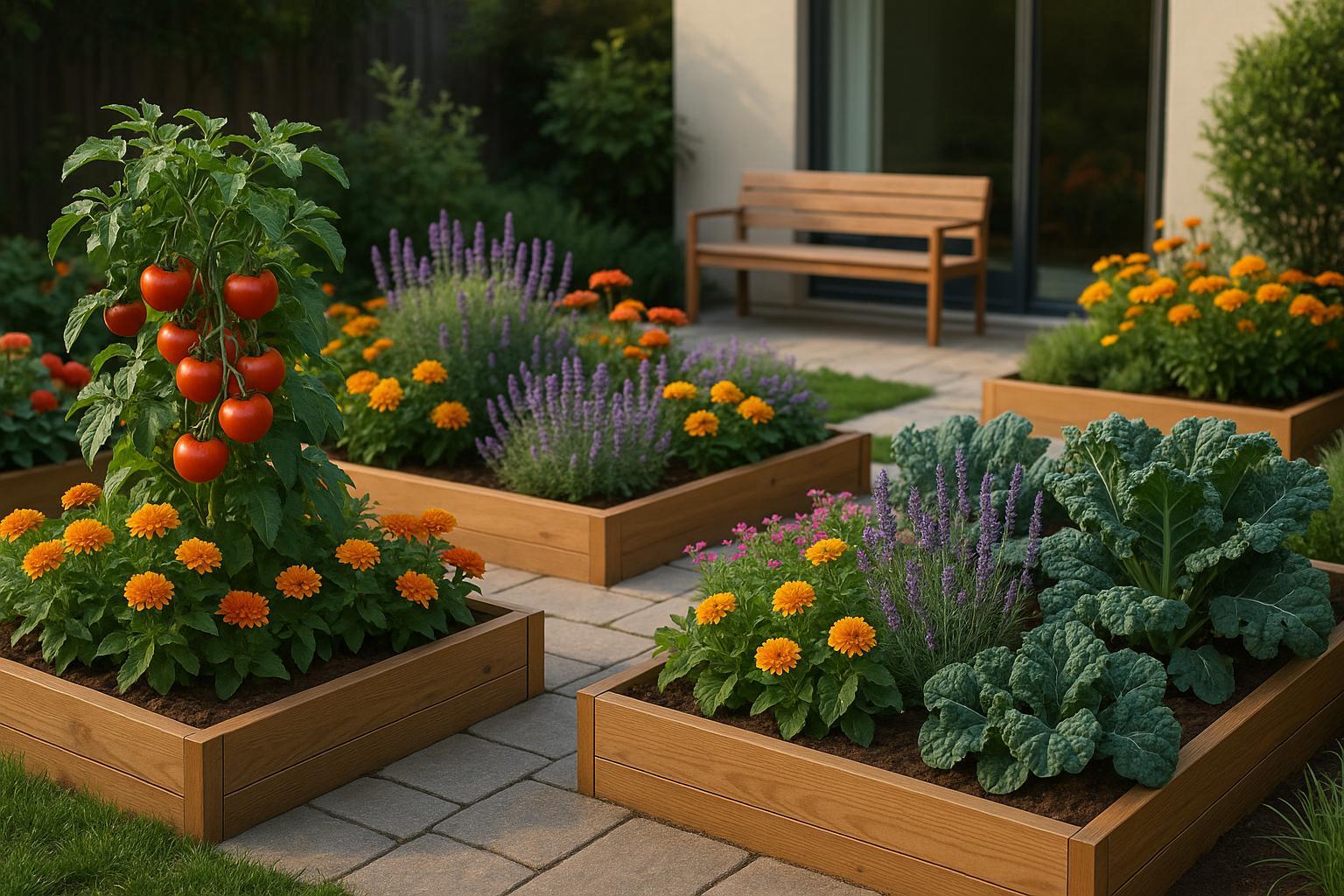
AI Tools for Edible-Ornamental Garden Design
Explore how AI tools revolutionize edible-ornamental garden design with instant plans, personalized plant suggestions, and smart maintenance tips.